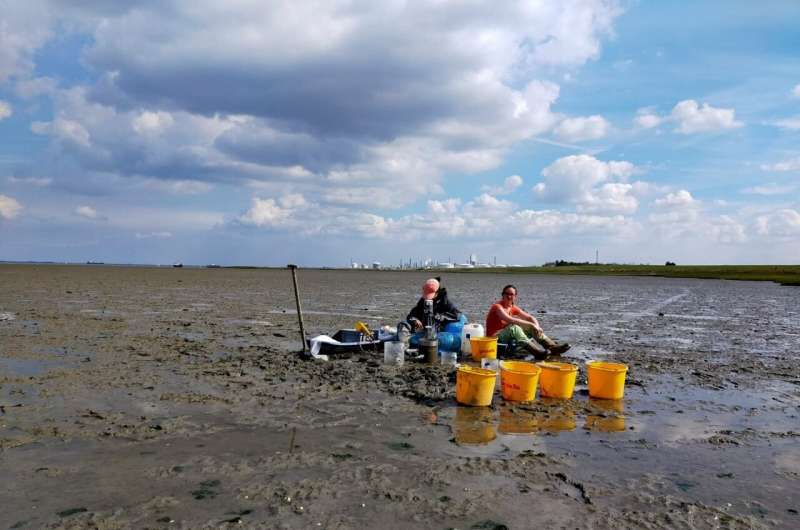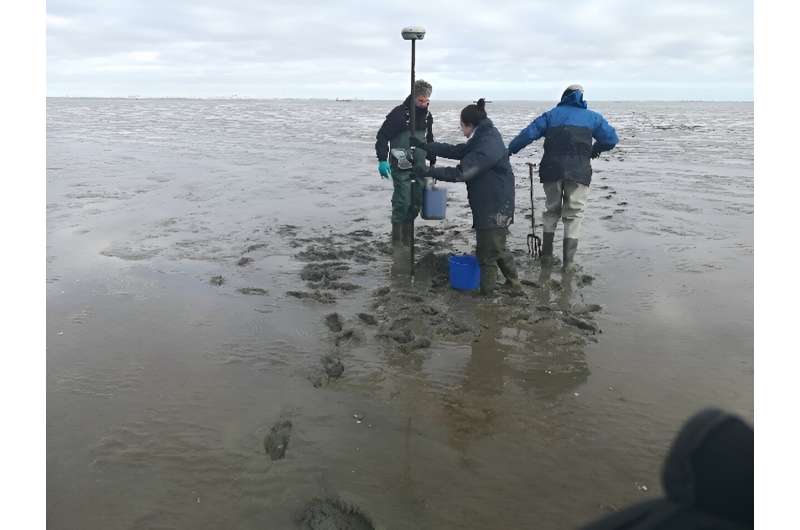This article has been reviewed according to Science X's editorial process and policies. Editors have highlighted the following attributes while ensuring the content's credibility:
fact-checked
trusted source
proofread
Stronger storms free more nutrients from mud flats, finds researcher

If storms become stronger in the future due to climate change, more nitrogen may be released from the bottom of coastal seas. This is shown by the research of marine biogeochemist Dunia Rios-Yunes at NIOZ in Yerseke. Rios-Yunes will defend her Ph.D. thesis today at the University of Utrecht. "The dynamics of nutrients in deltas and estuaries have been a bit of a blind spot for marine science so far," she says.
For her experiments, Rios-Yunes spent many hours on an inflatable couch on the dry bottom of the Wester-Oosterschelde.
"I mimicked a storm on the mud, using a bucket without a bottom and a big blender, stirring up the mud and measuring the release or the uptake of nitrogen and phosphorous. But, since I needed to do this for six hours in a row, I rapidly found out that I needed a little bit of comfort sitting in the mud. The inflatable couch was my lifesaver during the fieldwork," she jokingly says.
More nitrogen, less phosphorous
Rios-Yunes found out that considerable amounts of nitrogen are released when her experimental storm stirs the bottom. "In just a couple of hours, the amount of nitrogen that is normally released in weeks may come out of the mud during one storm. This means that many more nutrients become available in the water column, and these could be used algae to grow." Phosphorous, on the other hand, was taken up during the 'storm' in the Oosterschelde but released in the Westerschelde.
"This may be because of the differences in chemical composition of the mud between an estuary and a tidal bay."

Storage of nutrients like nitrogen and phosphorous, but also of many trace elements, is considered a crucial ecosystem service of places like the Wester-Oosterschelde. This ecosystem service is under increasing pressure, Rios-Yunes explains. For example, the Oosterschelde coast is relatively important for the storage of nutrients compared to the subtidal sea bottom.
But due to the Oosterschelde storm surge barrier and also with rising sea levels in the future, the coast of the Oosterschelde is 'eaten by the currents." "Therefore, relatively large amounts of nutrients may become available for algae and other organisms."
Temperature and salinity, as well as benthic animals, also influence the chemistry of the tidal sea floor. "But these phenomena have not been studied a lot so far," Rios-Yunes says. "For fundamental research into the dynamics of nutrients and other equilibria in tidal areas, it is very important to understand the role of temperature, salinity, benthic animals and also turmoil by storms."
Policymakers and keepers of natural areas like the Oosterschelde should also understand the dynamics of nutrients in a changing world, Rios-Yunes says. "My research stresses the importance of keeping the cost of these tidal areas in good condition, and thus avoid losing the valuable ecosystem services they provide."
More information: Dunia Rios-Yunes, Biogeochemical interactions in delta systems: present state and future challenges, Utrecht University (2024). DOI: 10.33540/2139 dspace.library.uu.nl/handle/1874/433947
Provided by Royal Netherlands Institute for Sea Research


















